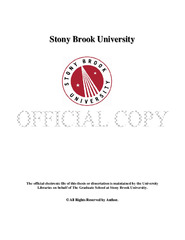| dc.identifier.uri | http://hdl.handle.net/11401/77034 | |
| dc.description.sponsorship | This work is sponsored by the Stony Brook University Graduate School in compliance with the requirements for completion of degree. | en_US |
| dc.format | Monograph | |
| dc.format.medium | Electronic Resource | en_US |
| dc.language.iso | en_US | |
| dc.publisher | The Graduate School, Stony Brook University: Stony Brook, NY. | |
| dc.type | Dissertation | |
| dcterms.abstract | Metal-based nanomaterials have attracted significant research interest due to their unique size-dependent optical, magnetic, electronic, thermal, mechanical, and chemical properties as compared with their bulk counterparts. These advantageous and tailorable properties render these materials as ideal candidates for catalysis, photovoltaics, and even biomedical applications. However, nanomaterials are typically synthesized via chemical or physical processes, which are continuing to rise in cost, complexity, and toxicity. As a result, ‘milder’ and more environmentally benign nanoscale synthetic methodologies, particularly U-tube double diffusion, molten salt, and hydrothermal techniques, have been utilized to mitigate for these drawbacks. Moreover, these efficient and facile techniques coupled with the unique attributes of nanomaterials will aid in a more practical translation from the lab scale to industry with potential applications spanning from electronics, energy, to medicine. In this thesis, we will discuss the sustainable synthesis of crystalline elemental copper (Cu), nickel (Ni), magnetic spinel ferrites (MFe2O4 wherein M is Co, Ni, or Zn), rare earth ion doped-calcium titanate (RE-CaTiO3), and hematite (α-Fe2O3) as well as our ability to tailor the size and/or morphology and hence tune their properties for potential applications in solar cells and biomedicine. Specifically, for the Cu and Ni nanowires (NWs), the diameters have been dictated by the various template diameters used in the U-tube double diffusion technique. Subsequently, their photocatalytic properties were observed when coupled with TiO2 NPs. For MFe2O4, RE-CaTiO3, and α-Fe2O3 nanostructures, the hydrothermal method was employed wherein various parameters such as reaction temperature, concentration, and addition of surfactant were varied to influence their morphology and/or composition. For example, as the reaction temperature was increased, ultrasmall MFe2O4 particles transformed from amorphous to crystalline species, and these were subsequently investigated for their magnetic properties as well as for their potential as photocatalysts. Regarding RE-CaTiO3, a comparison and correlation between their preparative synthetic techniques (i.e. hydrothermal and molten salt) and photoluminescent properties were explored. Moreover, quantum dots (QDs) were coupled onto RE-CaTiO3 to observe possible charge transfer effects. Lastly for α-Fe2O3, microglial uptake of NPs, activation, and possible cytotoxic effects were all probed | |
| dcterms.abstract | Metal-based nanomaterials have attracted significant research interest due to their unique size-dependent optical, magnetic, electronic, thermal, mechanical, and chemical properties as compared with their bulk counterparts. These advantageous and tailorable properties render these materials as ideal candidates for catalysis, photovoltaics, and even biomedical applications. However, nanomaterials are typically synthesized via chemical or physical processes, which are continuing to rise in cost, complexity, and toxicity. As a result, ‘milder’ and more environmentally benign nanoscale synthetic methodologies, particularly U-tube double diffusion, molten salt, and hydrothermal techniques, have been utilized to mitigate for these drawbacks. Moreover, these efficient and facile techniques coupled with the unique attributes of nanomaterials will aid in a more practical translation from the lab scale to industry with potential applications spanning from electronics, energy, to medicine. In this thesis, we will discuss the sustainable synthesis of crystalline elemental copper (Cu), nickel (Ni), magnetic spinel ferrites (MFe2O4 wherein M is Co, Ni, or Zn), rare earth ion doped-calcium titanate (RE-CaTiO3), and hematite (α-Fe2O3) as well as our ability to tailor the size and/or morphology and hence tune their properties for potential applications in solar cells and biomedicine. Specifically, for the Cu and Ni nanowires (NWs), the diameters have been dictated by the various template diameters used in the U-tube double diffusion technique. Subsequently, their photocatalytic properties were observed when coupled with TiO2 NPs. For MFe2O4, RE-CaTiO3, and α-Fe2O3 nanostructures, the hydrothermal method was employed wherein various parameters such as reaction temperature, concentration, and addition of surfactant were varied to influence their morphology and/or composition. For example, as the reaction temperature was increased, ultrasmall MFe2O4 particles transformed from amorphous to crystalline species, and these were subsequently investigated for their magnetic properties as well as for their potential as photocatalysts. Regarding RE-CaTiO3, a comparison and correlation between their preparative synthetic techniques (i.e. hydrothermal and molten salt) and photoluminescent properties were explored. Moreover, quantum dots (QDs) were coupled onto RE-CaTiO3 to observe possible charge transfer effects. Lastly for α-Fe2O3, microglial uptake of NPs, activation, and possible cytotoxic effects were all probed | |
| dcterms.available | 2017-09-20T16:51:44Z | |
| dcterms.contributor | Wong, Stanislaus S | en_US |
| dcterms.contributor | Sampson, Nicole S | en_US |
| dcterms.contributor | Grubbs, Robert B | en_US |
| dcterms.contributor | Drueckhammer, Dale. | en_US |
| dcterms.creator | Lewis, Crystal | |
| dcterms.dateAccepted | 2017-09-20T16:51:44Z | |
| dcterms.dateSubmitted | 2017-09-20T16:51:44Z | |
| dcterms.description | Department of Chemistry | en_US |
| dcterms.extent | 294 pg. | en_US |
| dcterms.format | Monograph | |
| dcterms.format | Application/PDF | en_US |
| dcterms.identifier | http://hdl.handle.net/11401/77034 | |
| dcterms.issued | 2016-12-01 | |
| dcterms.language | en_US | |
| dcterms.provenance | Made available in DSpace on 2017-09-20T16:51:44Z (GMT). No. of bitstreams: 1
Lewis_grad.sunysb_0771E_12960.pdf: 59431607 bytes, checksum: eb41de413d9acf378ff9e589c2b752a2 (MD5)
Previous issue date: 1 | en |
| dcterms.publisher | The Graduate School, Stony Brook University: Stony Brook, NY. | |
| dcterms.subject | Nanomaterials, Nanowires, Toxicology | |
| dcterms.subject | Chemistry -- Nanoscience | |
| dcterms.title | Green Synthesis, Characterization, and Application of Metal-based Nanomaterials | |
| dcterms.type | Dissertation | |

